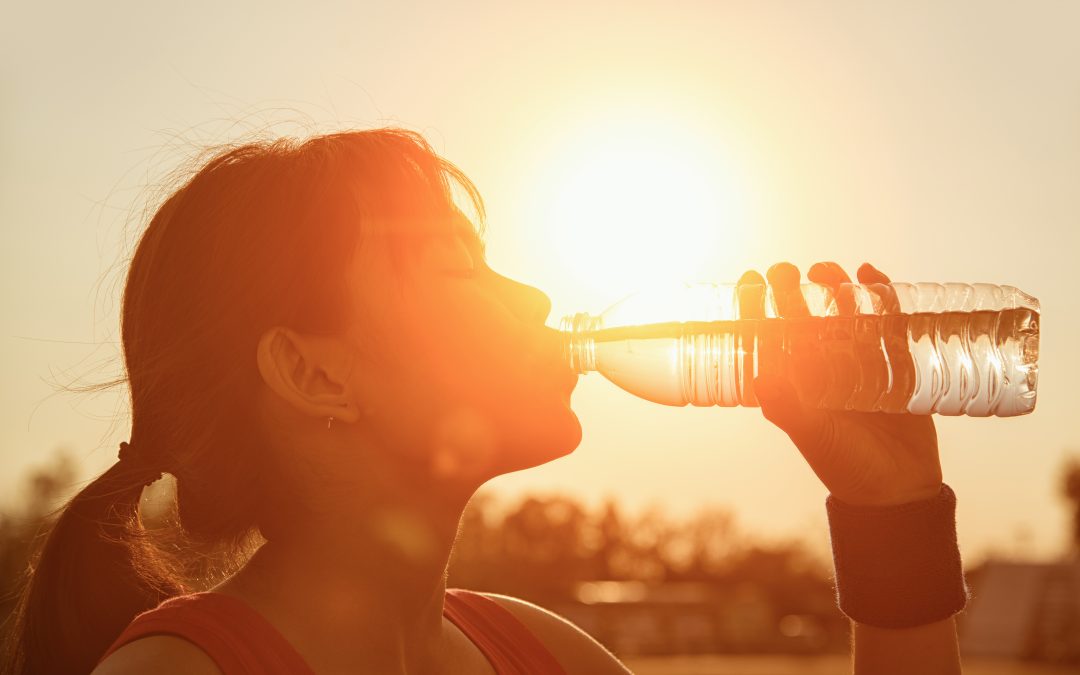Summers in Houston, where I live, are hot. I mean REALLY hot. And not just hot, but humid too. The heat and humidity add another level of difficulty to maintaining outdoor exercise and sports routines. Staying active during these hot summers is a challenge, but with a little bit of planning you can continue to enjoy your outdoor activities despite the sweltering heat of summer.
As we age our ability to tolerate the heat diminishes – especially for folks over the age of 65. One reason for this is reduced blood flow to the skin. If blood can’t get to the skin then the body loses its ability to release heat by sweating. Other factors that can contribute to heat intolerance include obesity, heart disease, various medications, and alcohol use.
[Important disclaimer: If you have any type of chronic disease such as heart disease, diabetes, kidney disease, or history of seizures or stroke or take any prescriptions including, but not limited to, beta-blockers or diuretics, you should consult your primary care provider before beginning any activities that expose you to increased temperatures.]
Hydrate, hydrate, hydrate
Maintaining adequate hydration is always important for optimal health, but even more so when you are hot and sweating. Drink water before, during, and after physical exercise. Don’t wait until you feel thirsty. A good gauge of adequate hydration is that your urine is very light yellow to clear.
If you are sweating profusely, drinking water alone is not enough. The body loses salt (sodium and chloride) and small amounts of potassium and magnesium in sweat, and these electrolytes need to be replenished as well. Most sports drinks are actually relatively low in sodium, so if you are exercising outside for more than an hour and sweating a lot you may need to add some salt to your drink.
Limit or avoid drinks that have diuretic properties such as alcohol, coffee, and tea.
Acclimate
You can improve your heat tolerance by slowly increasing the amount of time you are active or exercise in the heat. I learned this when I started doing hot yoga many years ago. It felt so hot that many times I wanted to walk right back out as soon as I entered the room.. I was miserable and would count the minutes until class was over so I could get out of the hot yoga room. I was obsessed about drinking lots of water before each class and could hardly wait for each designated water break. But after about six months, I realized that I wasn’t hating the heat as much, and after about a year it hardly bothered me at all.
This is a pretty extreme example of acclimating to heat, but it demonstrates that the body will adjust to its environment over time. Adjusting the amount of time you spend walking or working in the yard by say, fifteen minutes every week or so, will allow your body to make the adjustments necessary to feel more comfortable as temperatures increase throughout the season.
Monitor and Adjust
If you’re planning an outdoor activity, check out the weather report the day before. The most important piece of information to be aware of is the heat index. This is a measure of how hot it feels based on combined air temperature and relative humidity. Increased humidity limits the ability for your sweat to evaporate and cool the skin, leading to increased body temperatures. A heat index between 90 and 100 requires extra caution, and over 100 requires extreme care.
For instance, the other day, between one and two p.m., as I was walking across the Costco parking lot and it felt hotter than the hottest hot yoga room I’d ever been in, the air temperature was 95 degrees and the humidity was 51% – creating a heat index of 106 degrees!
So when the heat, and the heat index, is rising, adjust your activities accordingly – do outdoor activities earlier in the day, take your exercise routine indoors, or take the day off and enjoy some rest.
Take Cover
Wearing sunscreen is a must anytime you are outdoors and especially on hot and sunny days. Using sunscreen reduces your risk of skin cancer and helps prevent aging. Experts recommend using sunscreen with an SPF of at least 30 and reapplying at least every two hours. If you are sweating a lot, the sunscreen will wash off – so you may need to reapply more often.
Wearing a hat is another must when outdoors in the sun. Since many parts of your head are difficult to protect with sunscreen, such as the ears, scalp, and back of the neck – wearing a wide-brimmed hat will protect your head, face, and neck from the sun’s rays.
Last but not least, proper clothing will help protect you from the sun as well as improve your heat tolerance. Light-colored and loose, light-weight clothing will reflect the heat and feel cooler against the skin. Cotton is usually a good choice, but if you will be sweating a lot cotton is not ideal since it will absorb and trap moisture, preventing evaporation. Nylon, polyester, and technical or performance fabrics are good choices for hot weather clothing since they are lightweight and breathable – wicking moisture away from the skin. Some activewear also boast ultraviolet protection factor (UPF) ratings of 15-50, giving you additional protection from potentially harmful ultraviolet (UV) rays.
Conclusion
Don’t let the heat interfere with your commitment to maintaining regular physical activity! Just use some common sense and take precautions so that you can continue to maintain your routine of outdoor activities throughout the entire year.

